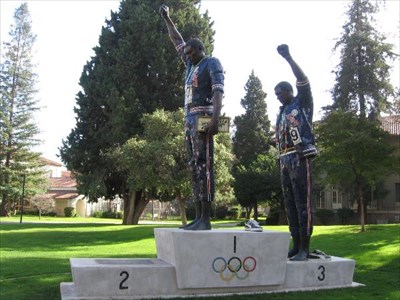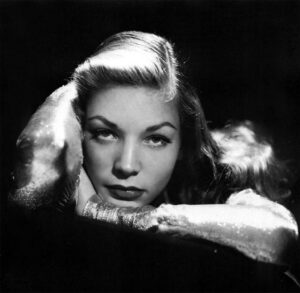1968 was a year of racial division and tragedy. African American’s had discussed the possibility of a boycott of the 1968 Summer Olympics. Dr. Martin Luther King Jr., a huge supporter of this boycott, said he would join Olympians John Carlos and Tommie Smith in Mexico to protest.1 These boycotts slowly fell through the cracks following the assassination of Martin Luther King Jr., and the riots during the Holy Week uprising. These riots were a direct response to the tragic death of MLK. Now that Dr. King would no longer be joining John Carlos in Mexico, other athletes became skeptical in boycotting the Summer Olympics. African American athletes began to change their stance on the boycott. The Olympians decided they would rather compete for themselves and their country, rather than sit out for a protest that would have a lot of attention in the media. But, John Carlos still felt like something needed to be done about the racially divided nation he lived in. With just a few weeks until the 1968 Summer Olympic Games, John Carlos had to decide how he would make his stand without the help or support of other Olympians or the civil rights activist Martin Luther King.2

With just ten days until the opening of the Summer Games, an unarmed group of student protesters gathered in Mexico City’s Three Cultures Square to plan their next step as a movement. The Mexican government sent bulldozers to break up the thousands of people who had gathered there. Mexican troops fired into the crowd, injuring and taking the lives of many people.3
This tragedy was eye-opening for both Carlos and Smith. Being in Mexico helped them to realize that they lived in a world that was unjust for all kinds of people. So the two decided that they needed to make a stand, and to be a voice for the voiceless.4 John Carlos and Tommie Smith knew that if they wanted to make a stand, it was imperative that they compete well enough to end up on the podium for the world to see.
Prior to their races, John Carlos and Tommie Smith decided that they both needed to make the podium together to make their stand through symbolism. The two men decided they would wear black gloves to symbolize strength and unity. They also wore beads around their necks to represent the history of lynching, and they decided to not wear shoes to symbolize black poverty in America.5 John Carlos and Tommie Smith wanted to do this because they felt that something needed to call attention to the broken and discriminated nature of their country. They wanted to make sure people were aware that there were those who lived in the “land of the free” that were far from free in terms of oppression.
The qualifying rounds had finally begun, and Tommie, unfortunately, pulled his groin in the quarter semi-finals. He refused to sit out though. Tommie was determined to compete because, to him, the race was so much bigger than he was, and bigger than anything else happening at the Olympics that summer.6
200m Final | Courtesy of Youtube
The finals had finally arrived. The next twenty seconds would be a defining moment for the two men. The gun sounded and the two flew. Tommie had a slow start but ended up setting a world record with a time of 19.57. John Carlos finished third, bested by Peter Norman by one step. But the two had made the podium, and it was time for them to make their stand. John Carlos told Norman what was about to happen, and Norman placed a button on him that read “We are Olympic Project for Human Rights,” to support the two men he was about to stand with on the podium.7

Carlos and Smith finally got their time on the podium, and as the two men’s fists shot up, 50,000 people fell silent. When the two walked toward the tunnel, following the National Anthem, people began booing and throwing things at them, screaming at them things like “Niggers need to go back to Africa,” and “I can’t believe this is how you Niggers treat us after we let you run in our games.”8 Then, in the midst of all this, the two stopped, threw their fists up again, screamed “right on,” and ran off the track.
The two got on the bus to begin the ride back to Olympic Village, and they got a glimpse of the rude awakening they were about to receive upon returning to the United States. As the two were about to sit down in the bus, a white man shouted: “those are the two that spit on my flag, you must be some kind of Communist.”9 The man continued badgering them until they arrived at Olympic Village.10
As the Olympics progressed, the USA Track team supported Carlos and Smith, and made signs to display throughout the remaining events. Following the United States winning the 4×100 relay finals, the team dedicated their win in an interview to Carlos and Smith. The US Olympic Committee was furious with the negative press that John Carlos and Tommie Smith were receiving for the scene they had caused, and the US Olympic Committee told the US team to either fly home or kick the two men off the team.11
Carlos and his wife were being bothered by the press constantly, and as they were heading to their hotel room one night, Carlos snapped and told the press: “Listen, I’m pretty pissed off with some of you white folk out there. The next one that takes a camera and microphone and sticks it up in my face, I am going to knock you down and act like you stole something.”12 These comments only escalated a situation that was already being blown up in the United States.13
After John Carlos and Tommie Smith returned home, they were suspended from the United States track team for making a scene on international television. And they began receiving death threats from many people.14 They were also being slammed in the media. Reporters called them “Blacked Skinned Storm Troopers,” while comparing their peaceful protest to a “Nazi Salute.”15 So much of the nation was infuriated with what these men had done. Some African Americans had even told them that they “set back black people 100 years.”16 The two refused to let the backlash quiet their message though, and they began speaking at colleges and in cities around the country to discuss equality in America. These men stood for something they believed in and got slandered in the media all over the world.17

Carlos and Smith felt like something needed to be done about the way people treated African Americans in America, and they refused to stand by and be complacent with the slow progress the United States had been making. It was not until 2008 that they received an ESPY award and were recognized in the media for their brave action.18 It’s truly tragic to see how these men were treated following the 1968 Summer Olympics, but it’s inspiring to see people fight and stand for what they believed in to call attention to issues they felt weren’t being adequately addressed in the United States. These men are part of the reason why we have made such great strides in the struggle for equality in America today.
- Erin Blakemore, “How the Black Power Protest at the 1968 Olympics Killed Careers,” History.com, February 22, 2018. Accessed February 14, 2019. https://www.history.com/news/1968-mexico-city-olympics-black-power-protest-backlash. ↵
- John Carlos, The John Carlos Story: The Sports Moment That Changed the World (Chicago, Illinois: Haymarket Books, 2011), 90-97. ↵
- Erin Blakemore, “How the Black Power Protest at the 1968 Olympics Killed Careers,” History.com, February 22, 2018. Accessed February 14, 2019. https://www.history.com/news/1968-mexico-city-olympics-black-power-protest-backlash. ↵
- Erin Blakemore, “How the Black Power Protest at the 1968 Olympics Killed Careers,” History.com, February 22, 2018. Accessed February 14, 2019. https://www.history.com/news/1968-mexico-city-olympics-black-power-protest-backlash. ↵
- John Carlos, The John Carlos Story: The Sports Moment That Changed the World (Chicago, Illinois: Haymarket Books, 2011), 110. ↵
- John Carlos, The John Carlos Story: The Sports Moment That Changed the World (Chicago, Illinois: Haymarket Books, 2011), 111-112. ↵
- John Carlos, The John Carlos Story: The Sports Moment That Changed the World (Chicago, Illinois: Haymarket Books, 2011), 112-113. ↵
- John Carlos, The John Carlos Story: The Sports Moment That Changed the World (Chicago, Illinois: Haymarket Books, 2011), 121. ↵
- John Carlos, The John Carlos Story: The Sports Moment That Changed the World (Chicago, Illinois: Haymarket Books, 2011), 123. ↵
- John Carlos, The John Carlos Story: The Sports Moment That Changed the World (Chicago, Illinois: Haymarket Books, 2011), 123. ↵
- Erin Blakemore, “How the Black Power Protest at the 1968 Olympics Killed Careers,” History.com, February 22, 2018. Accessed February 14, 2019. https://www.history.com/news/1968-mexico-city-olympics-black-power-protest-backlash. ↵
- John Carlos, The John Carlos Story: The Sports Moment That Changed the World (Chicago, Illinois: Haymarket Books, 2011), 124. ↵
- John Carlos, The John Carlos Story: The Sports Moment That Changed the World (Chicago, Illinois: Haymarket Books, 2011), 127. ↵
- John Carlos, The John Carlos Story: The Sports Moment That Changed the World (Chicago, Illinois: Haymarket Books, 2011), 130. ↵
- DeNeen L. Brown, “They didn’t #TakeTheKnee: The Black Power protest salute that shook the world in 1968,” The Washington Post, September 24, 2017. Accessed February 14, 2019. https://www.washingtonpost.com/news/retropolis/wp/2017/09/24/they-didnt-takeaknee-the-black-power-protest-salute-that-shook-the-world-in-1968/?utm_term=.97f6d2d0f51a. ↵
- “Sprinters are Both Suspended Because of Protest,” The Parsons Sun, Kansas, October 18, 1968. ↵
- DeNeen L. Brown, “They didn’t #TakeTheKnee: The Black Power protest salute that shook the world in 1968,” The Washington Post, September 24, 2017. Accessed February 14, 2019. https://www.washingtonpost.com/news/retropolis/wp/2017/09/24/they-didnt-takeaknee-the-black-power-protest-salute-that-shook-the-world-in-1968/?utm_term=.97f6d2d0f51a. ↵
- DeNeen L. Brown, “They didn’t #TakeTheKnee: The Black Power protest salute that shook the world in 1968,” The Washington Post, September 24, 2017. Accessed February 14, 2019. https://www.washingtonpost.com/news/retropolis/wp/2017/09/24/they-didnt-takeaknee-the-black-power-protest-salute-that-shook-the-world-in-1968/?utm_term=.97f6d2d0f51a. ↵



57 comments
Shriji Lalji
Interesting how history repeats itself. These men put their hands up in the air during their podium ceremony as a symbol of solidarity toward the fight for equality. Now athletes kneel during the national anthem due to the way the law enforcement and the criminal justice system treat them. Athletes continue to use their platform to fight for equality. It is just sad to see nothing has changed. African Americans have been fighting for equality since the creation of our country.
Aaron Sandoval
This article was an interesting read and a topic that I can vaguely remember learning about in a history class in high school. This article helped bring back the little knowledge I had as well as add more to what I had already known. This decade was always an interesting one, with so many drastic events occurring back to back, and I feel the power of this moment is overshadowed with the many assassinations that occurred in this decade along with the protesting, and I think there is much that can be taken from learning about these two brave men who risked their athletic careers to make an impact.
Carlos Apodaca
I enjoyed reading this article and the way it told the story about the increible act that John Carlos and Tommie Smith did during the 1969 Olympics. Im glad that the two athletes werent afraid to do this even after MLK’s death and knowing the backlash that they would recieve. They were a huge influence in the fight for equality that is going on till this day in the United States. Im glad they were recognized in 2008 by recieving the ESPY award because it showed that the sports world was inspired by them.
Jacqueline Mendez
Very well written article and very eye-opening. This isn’t the first Olympics games they have tried to boycott. But this one definitely means something more. They knew even though they had one they would come back to a country that still hates them and will tear them apart just for the color of their skin. I love how in the article you put a video. It made it more interactive.
Saira Locke
This article is very empowering because it describes a very real situation in which segregation and racism was a huge issue. It is very sad thinking of the reality of our society used to be, we have definitely gotten better but that’s not to racism doesn’t exist. It is sadly still an issue to this day but I feel as though brave acts such as the black power salute are very important to really put into perspective how unfair our society can be.
Judy Reyes
Wow, this was such as empowering article. I had never heard about this event happening. Despite the backlash both John Carlos and Tommie Smith had gotten from taking a stand, that did not stop them. I loved the phrase that was added in the article, “So the two decided that they needed to make a stand, and to be a voice for the voiceless.” It amazed me that they were not positively recognized for taking a stand until the ESPYs in 2008.
Sebastian Azcui
I remember writing about this back in High School and it is a very interesting story! Definitely the 1968 Olympics were remarkable with the Black Power salute with both John Carlos and Tommie Smith. It was very courageous of their part to do this in front of everyone and doing it with passion. They are defending their rights and want equality for everyone. The sad part is that racism and many other horrible acts still exist and affect our sports or other things.
Mitchell Yocham
It’s unbelievable to me that African Americans were treated this badly even if it were for the USA team. It’s so disturbing to me that they received backlash from everyone for being proud of their accomplishments and being proud of their race and country.
Andrea Degollado
This article was incredible! The courage these two olympians had is truly inspiring. These two men, knowing what they would face, still had the courage to do this selfless act. They weren’t thinking of themselves, like the article says when Tommie got injured he still decided to continue because this event was much bigger than himself. This is an inspirational story.
Felipe Macias
Its amazing to see the effects of segregation and the limits people break in order to achieve justice for what is deemed wrong. This portrays the human instinct to evolve and adapt, the want for change and positivism. With black leaders and movement activists, it is not difficult to want to and effective act against an offensive set of laws.